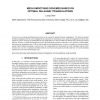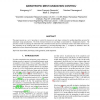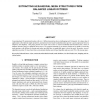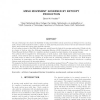IMR
2004
Springer
14 years 5 months ago
2004
Springer
We compare inexact Newton and coordinate descent methods for optimizing the quality of a mesh by repositioning the vertices, where quality is measured by the harmonic mean of the ...
IMR
2004
Springer
14 years 5 months ago
2004
Springer
In the finite element analysis that deals with large deformation, the process usually produces distorted elements at the later stages of the analysis. These distorted elements lea...
IMR
2004
Springer
14 years 5 months ago
2004
Springer
We introduce an indexing scheme for the vertices of semi-regular meshes, based on interleaving quadtrees rooted on the edges of the base mesh. Using this indexing scheme we develo...
IMR
2004
Springer
14 years 5 months ago
2004
Springer
We present several mesh smoothing schemes based on the concept of optimal Delaunay triangulations. We define the optimal Delaunay triangulation (ODT) as the triangulation that mi...
IMR
2004
Springer
14 years 5 months ago
2004
Springer
The paper presents an a priori procedure to control the element size and shape variation for meshing algorithms governed by anisotropic sizing specifications. The field of desir...
IMR
2004
Springer
14 years 5 months ago
2004
Springer
IMR
2004
Springer
14 years 5 months ago
2004
Springer
We describe some extensions to the grid smoothing scheme described in [1, 2] that deal with the following issues: 1) the clustering effect of changing valence in an unstructured ...
IMR
2004
Springer
14 years 5 months ago
2004
Springer
Generating large 3D unstructured meshes with over 1 billion elements has been a challenging task. Fortunately, for a large class of applications with relatively simple geometries,...
IMR
2004
Springer
14 years 5 months ago
2004
Springer
We propose a new two-dimensional meshing algorithm called PINW able to generate meshes that accurately approximate the distance between any two domain points by paths composed onl...
IMR
2004
Springer
14 years 5 months ago
2004
Springer
The aim of this paper is to study the feasibility of using (irreversible) entropy production as driving force for a moving mesh. Such a method should be able to capture or track p...




